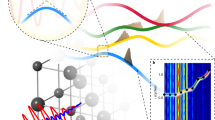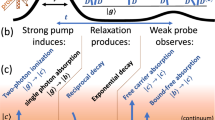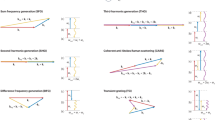Abstract
The Fano effect1 is ubiquitous in the spectroscopy of, for instance, atoms1,2, bulk solids3,4 and semiconductor heterostructures5,6,7. It arises when quantum interference takes place between two competing optical pathways, one connecting the energy ground state and an excited discrete state, the other connecting the ground state with a continuum of energy states. The nature of the interference changes rapidly as a function of energy, giving rise to characteristically asymmetric lineshapes. The Fano effect is particularly important in the interpretation of electronic transport5,6 and optical spectra7,8 in semiconductors. Whereas Fano’s original theory1 applies to the linear regime at low power, at higher power a laser field strongly admixes the states and the physics becomes rich, leading, for example, to a remarkable interplay of coherent nonlinear transitions9. Despite the general importance of Fano physics, this nonlinear regime has received very little attention experimentally, presumably because the classic autoionization processes2, the original test-bed of Fano’s ideas1, occur in an inconvenient spectral region, the deep ultraviolet. Here we report experiments that access the nonlinear Fano regime by using semiconductor quantum dots, which allow both the continuum states to be engineered and the energies to be rescaled to the near infrared. We measure the absorption cross-section of a single quantum dot and discover clear Fano resonances that we can tune with the device design or even in situ with a voltage bias. In parallel, we develop a nonlinear theory applicable to solid-state systems with fast relaxation of carriers. In the nonlinear regime, the visibility of the Fano quantum interferences increases dramatically, affording a sensitive probe of continuum coupling. This could be a unique method to detect weak couplings of a two-level quantum system (qubits), which should ideally be decoupled from all other states.
This is a preview of subscription content, access via your institution
Access options
Subscribe to this journal
Receive 51 print issues and online access
$199.00 per year
only $3.90 per issue
Buy this article
- Purchase on Springer Link
- Instant access to full article PDF
Prices may be subject to local taxes which are calculated during checkout



Similar content being viewed by others
References
Fano, U. Effects of configuration interactions on intensities and phase shifts. Phys. Rev. 124, 1866–1878 (1961)
Madden, R. P. & Codling, K. New autoionizing atomic energy levels in He, Ne, and Ar. Phys. Rev. Lett. 10, 516–518 (1963)
Cerdeira, F., Fjeldly, T. A. & Cardona, M. Effect of free carriers on zone-center vibrational modes in heavily doped p-type Si. II. Optical modes. Phys. Rev. B 8, 4734–4745 (1973)
Hase, M., Demsar, J. & Kitajima, M. Photoinduced Fano resonance of coherent phonons in zinc. Phys. Rev. B 74, 212301 (2006)
Faist, J., Capasso, F., Sirtori, C., West, K. W. & Pfeiffer, L. N. Controlling the sign of quantum interference by tunnelling from quantum wells. Nature 390, 589–592 (1997)
Schmidt, H., Campman, K. L., Gossard, A. C. & Imamoglu, A. Tunneling induced transparency: Fano interference in intersubband transitions. Appl. Phys. Lett. 70, 3455–3457 (1997)
Bar-Ad, S., Kner, S., Marquezini, M. V., Mukamel, S. & Chemla, D. S. Quantum confined Fano interference. Phys. Rev. Lett. 78, 1363–1366 (1997)
Wagner, J. & Cardona, M. Electronic Raman scattering in heavily doped p-type germanium. Phys. Rev. B 32, 8071–8077 (1985)
Rzazewski, K. & Eberly, J. H. Confluence of bound-free coherences in laser-induced autoionization. Phys. Rev. Lett. 47, 408–412 (1981)
Högele, A. et al. Voltage-controlled optics of a quantum dot. Phys. Rev. Lett. 93, 217401 (2004)
Zrenner, A. et al. Coherent properties of a two-level system based on a quantum dot photodiode. Nature 418, 612–614 (2002)
Gammon, D. & Steel, D. G. Optical studies of single quantum dots. Phys. Today 55, 36–41 (2002)
Stufler, S., Ester, P., Zrenner, A. & Bichler, M. Quantum optical properties of a single InxGa1-xAs-GaAs quantum dot two-level system. Phys. Rev. B 72, 121301(R) (2005)
Reithmaier, J. P. et al. Strong coupling in a single quantum dot-semiconductor microcavity system. Nature 432, 197–200 (2004)
Yoshie, T. et al. Vacuum Rabi splitting with a single quantum dot in a photonic crystal nanocavity. Nature 432, 200–203 (2004)
Peter, E. et al. Exciton-photon strong-coupling regime for a single quantum dot embedded in a microcavity. Phys. Rev. Lett. 95, 067401 (2005)
Hennessy, K. et al. Quantum nature of a strongly coupled single quantum dot-cavity system. Nature 445, 896–899 (2007)
Warburton, R. J. et al. Optical emission from a charge-tunable quantum ring. Nature 405, 926–929 (2000)
Loudon, R. The Quantum Theory of Light 3rd edn (Oxford Univ. Press, Oxford, 2000)
Kroner, M. et al. Resonant saturation laser spectroscopy of a single self-assembled quantum dot. Physica E (in the press)
Alén, B. et al. Absorptive and dispersive optical responses of excitons in a single quantum dot. Appl. Phys. Lett. 89, 123124 (2006)
Atatüre, M. et al. Observation of Faraday rotation from a single confined spin. Nature Phys. 3, 101–105 (2007)
Seidl, S. et al. Absorption and photoluminescence spectroscopy on a single self-assembled charge tunable quantum dot. Phys. Rev. B 72, 195339 (2005)
Rzazewski, K. & Eberly, J. H. Photoexcitation of an autoionizing resonance in the presence of offdiagonal relaxation. Phys. Rev. A 27, 2026–2042 (1983)
Smith, J. M. et al. Voltage control of the spin dynamics of an exciton in a semiconductor quantum dot. Phys. Rev. Lett. 94, 197402 (2005)
Govorov, A. O., Warburton, R. J. & Karrai, K. Kondo excitons in self-assembled quantum dots. Phys. Rev. B 67, 241307(R) (2003)
Bayer, M. et al. Inhibition and enhancement of the spontaneous emission of quantum dots in structured microresonators. Phys. Rev. Lett. 86, 3168–3171 (2001)
Zhang, W., Govorov, A. O. & Bryant, G. W. Semiconductor-metal nanoparticle molecules: hybrid excitons and non-linear Fano effect. Phys. Rev. Lett. 97, 146804 (2006)
Acknowledgements
We thank A. Högele for discussions and J. P. Kotthaus for support. The work was supported by SFB 631 (Germany), AvHF (Germany), EPSRC (UK), NSF (USA) and SANDiE (EU). B.D.G. thanks the Royal Society of Edinburgh for financial support. Financial support from the German Excellence Initiative via the Nanosystems Initiative Munich (NIM), and from Ohio University Nanobiotechnology Initiative, is acknowledged.
Author information
Authors and Affiliations
Corresponding author
Supplementary information
TITLE
This file contains Supplementary Figures 1-2 with Legends and Supplementary Theory including formulas. This file includes a general description of the Fano effect. The idea is to give a simple introduction to the Fano effect that can be understood even by “an enthusiastic student.” Furthermore it contains theoretical description for the coupling mechanism. (PDF 245 kb)
Rights and permissions
About this article
Cite this article
Kroner, M., Govorov, A., Remi, S. et al. The nonlinear Fano effect. Nature 451, 311–314 (2008). https://doi.org/10.1038/nature06506
Received:
Accepted:
Issue Date:
DOI: https://doi.org/10.1038/nature06506
This article is cited by
-
Plasmon coupling nanorice trimer for ultrahigh enhancement of hyper-Raman scattering
Scientific Reports (2021)
-
The multi-photon induced Fano effect
Nature Communications (2021)
-
Switchable Fano Resonance Based on Cut-Induced Asymmetric Split-Ring Resonators with Dirac Semimetal Film
Plasmonics (2021)
-
Probe response of a two-mode cavity with \(\chi^{\left( 2 \right)}\) non-linearity, non-reciprocity and slow and fast light
Applied Physics B (2021)
-
Tuning high-Q nonlinear dynamics in a disordered quantum magnet
Nature Communications (2019)
Comments
By submitting a comment you agree to abide by our Terms and Community Guidelines. If you find something abusive or that does not comply with our terms or guidelines please flag it as inappropriate.



